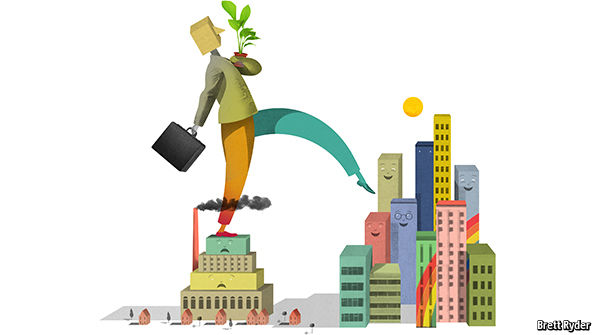
Image via the Economist
The Economist’s Schumpeter column this week was a great feature on the return of jobs to downtown from suburban office parks. I was delighted to be featured in it for my concept of the “executive headquarters” and the notion that these relocated HQs are often both different and smaller than in the past. (And what’s more, the relocation itself often involves downsizing).
I don’t want to claim too much credit, but I did help pioneer this concept of executive HQs in downtown, starting with a 2008 piece on the move of HQs into downtown Chicago. The revival of global cities was driven by financial and producer services. Saskia Sassen had pointed out that headquarters, conventionally viewed as the most important, were not the driver. I saw this starting to change as the corporate headquarters reinvented itself, focused on just those functions and executives that needed to move interface with the services of the global city. I continued to develop this idea over time, and I’m very glad it has proven useful and others are writing about the same.
Here’s an excerpt from the Economist:
Yet the new downtown headquarters are very different from the old ones, and not just because they are open-plan and trendy. They are far smaller. Often, firms are moving their senior managers to the city along with a few hundred digital workers. Moving back to Chicago’s centre has usually involved downsizing: Motorola Solutions’ HQ shrank from 2,900 to 1,100, and that of Archer Daniels Midland from 4,400 to 70. Many companies are deconstructing their headquarters and scattering different units and functions across the landscape, leaving most middle managers in the old buildings, or else moving them to cheaper places in the southern states. Aaron Renn of the Manhattan Institute, a think-tank, reckons that head offices are splitting into two types: old-fashioned “mass” headquarters in the sunbelt cities, and new-style “executive headquarters” of senior managers and wired workers in elite cities such as San Francisco, Chicago and Boston.
That suggests there will be no return to the broad-based urban prosperity of America’s golden age. San Francisco could be the template of the future. Its centre is divided between affluent young people who frequent vegan cafés and homeless people who smoke crack and urinate in the streets. Long-standing San Franciscans resent the way that the urban professionals have driven up property prices. And those young workers may fall out of love with the city centre when they have children and start worrying about the quality of schools and the safety of streets.
Click through to read the whole thing.
I developed this idea independently, but won’t claim I’m the only or even first person to come up with it. But it’s nice to see my framing of the issue in use in this Economist piece (and others like this Crain’s Chicago piece). It goes to show that (originally) independent writers can have an influence, even if many years later.
from Aaron M. Renn
http://www.urbanophile.com/2016/09/07/the-economist-on-jobs-returning-to-downtown/
No comments:
Post a Comment